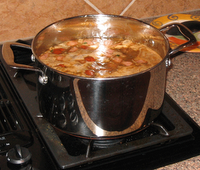Our home was situated about 100 feet from a public dirt road and about twice that distance from a large redwood barn my grandfather built to store corn, hay and farm equipment. Just behind the barn, about 20 yards away, was a small 50' x 100' pond which we dug to germinated the hundreds of sacks of rice seed prior to planting. Although the pond's main purpose was to germinate the seeds, it also served us in other ways—like raising fish and birds.
The pond was a playground for our domestic ducks and geese. About half of them were wild birds at one time before they became domesticated. You could tell which were wild and which were tamed by the color of their feet. The wild ones had green feet and the domesticated ones had yellow feet.
The lucky wild ones (the ones which were spared because only the tips of their wings were clipped by a shotgun blast during a hunt) in many cases went on to live a life of security and leisure on our farm pond.
There were times when my grandpa would nurse these 'fortunate' birds back to health and eventually release them with our domesticated birds. I gave them plenty to eat so they had no reason to leave our farm to find food elsewhere.
Many mornings, just after sunrise, (the domesticated wild ones I called them), would take flight and disappear into the horizon only to return a few moments later. Sometimes they would meet-up with a few stragglers in the sky and invite them back to our pond … and eventually to our dinner table. We had the best live decoys any duck hunter could hope for.
During the cold winter months, when we wanted to prepare duck gumbos or stews, my grandfather would walk inside the barn from the front entrance and quietly move to the back door which was purposely kept ajar a few inches—just wide enough to slide the barrel of a 12-gauge shotgun into position. He would then bag just enough wild birds to feed our family.
It was an ideal set-up. Pops didn't have to buy expensive hunting equipment or spend money on blinds and leases. I guess it was kind of like shooting fish in a barrel for him. The entire drama took less than 10 minutes and our farm birds (the live decoys) were content doing what they had always done best … quacking, flapping their wings, and playing in the water.
Have a great day. Bon Appetite!
The pond was a playground for our domestic ducks and geese. About half of them were wild birds at one time before they became domesticated. You could tell which were wild and which were tamed by the color of their feet. The wild ones had green feet and the domesticated ones had yellow feet.
The lucky wild ones (the ones which were spared because only the tips of their wings were clipped by a shotgun blast during a hunt) in many cases went on to live a life of security and leisure on our farm pond.
There were times when my grandpa would nurse these 'fortunate' birds back to health and eventually release them with our domesticated birds. I gave them plenty to eat so they had no reason to leave our farm to find food elsewhere.
Many mornings, just after sunrise, (the domesticated wild ones I called them), would take flight and disappear into the horizon only to return a few moments later. Sometimes they would meet-up with a few stragglers in the sky and invite them back to our pond … and eventually to our dinner table. We had the best live decoys any duck hunter could hope for.
During the cold winter months, when we wanted to prepare duck gumbos or stews, my grandfather would walk inside the barn from the front entrance and quietly move to the back door which was purposely kept ajar a few inches—just wide enough to slide the barrel of a 12-gauge shotgun into position. He would then bag just enough wild birds to feed our family.
It was an ideal set-up. Pops didn't have to buy expensive hunting equipment or spend money on blinds and leases. I guess it was kind of like shooting fish in a barrel for him. The entire drama took less than 10 minutes and our farm birds (the live decoys) were content doing what they had always done best … quacking, flapping their wings, and playing in the water.
Have a great day. Bon Appetite!
































